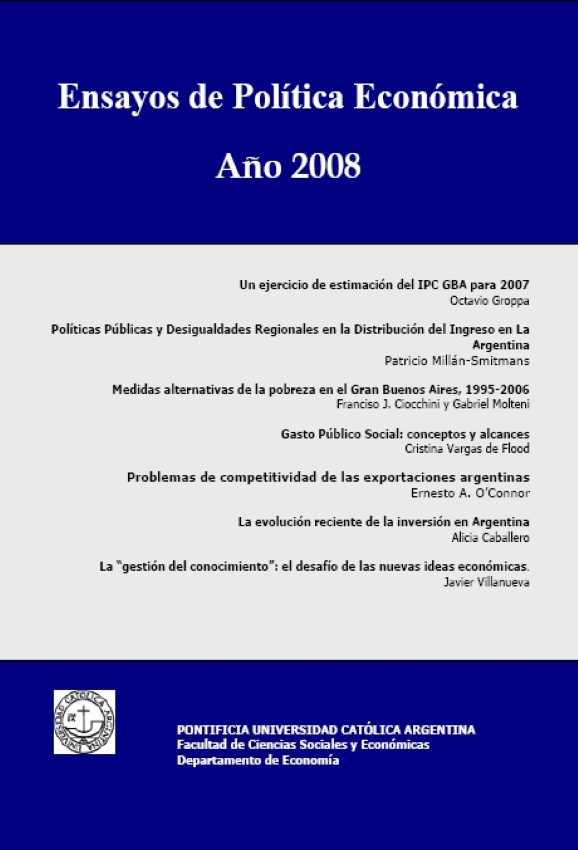Problems of export competitiveness Argentinian
Keywords:
Argentine exports, competitivenessAbstract
The Argentine economy is showing high economic growth since 2003, in a favorable global context. Exports grow incessantly, but the global market share is not modified. This raises questions on the exporting performance, and this paper shows some bounding of the competitiveness of the exports. The empirical information of Argentina and of the world is useful to determine some restrictions on the exports growth associated with the productive structure and the informality.
Downloads
References
Ahumada, H., A. Canavese, P. Canavese y F. González Alvaredo (2000). “El tamaño de la economía oculta. Revisión del método de estimación basado en la demanda de circulante con una ilustración para la Argentina”. en La Economía Oculta en la Argentina, FIEL, Buenos Aires, Argentina.
Engel, E., Alexander Galetovic y Claudio Raddatz (1998). "Estimación de la Evasión del IVA". Servicio de Impuestos Internos. Santiago de Chile, Chile.
Feldstein, M. (1978). “The Welfare Cost of Capital Income Taxation”, Journal of Political Economy, April, vol 86.
FIEL (2000). La Economía Oculta en la Argentina, Octubre. Ed. FIEL.
FIEL (2006). La Presión Tributaria sobre el Sector Formal de la Economía. Ed FIEL.
FMI (2006). Government Finance Statistics. Yearbook.
FMI (2006). International Financial Statistics. Yearbook.
Gordon, R., Laura Kalambokidis y Joel Slemrod (2004). “A New Summary Measure of the Effective Tax Rate on Investment”. En Measuring the Tax Burden on Capital and Labor, editado por Meter Birch Sorensen, pp. 99-128.
Johnson, S., Daniel Kaufman and Pablo Zoido-Lobatón (1998). “Corruption, public finances and the unofficial economy”. Washington, D.C.. The World Bank, discussion paper.
Giles, D. y Lindsay M. Tedds (2002) “Taxes and the Canadian Underground Economy”. Toronto: Canadian Tax Foundation.
Hausmann, R., Dani Rodrik and Andrés Velasco (2005). Growth Diagnostics. John F. Kennedy School of Government, Harvard University.
Hausmann, R., Jason Hwang, Dani Rodrik (2006). What You Export Matters. John F. Kennedy School of Government. Harvard University. October.
Hirschman, A. O. (1958). ”La estrategia del desarrollo económico”, Fondo de Cultura Económica.
IERAL de Fundación Mediterránea (2001). Una reforma tributaria integral para el crecimiento de la Argentina, Editorial IERAL.
IERAL de Fundación Mediterránea (2006). “Newsletter de la Competitividad Argentina”. Año 2 Nro. 4. Mayo de 2006.
Krugman, P. (1990). Geography and trade. Cambridge,MA: MIT Press.
Llach, J. J., Lucas Llach, Horacio Piffano, Cristina V. de Flood y M. Marcela Harriague (2001). “Más allá del IVA. Una reforma impositiva para mejorar la competitividad, la responsabilidad fiscal, el federalismo y la democracia representativa”, Buenos Aires, Asociación de Cámaras de Tecnología Agropecuaria y Cámara de Exportadores.
Llach J. J. y Marcela Harriague (2005). “Un sistema impositivo para el desarrollo y la equidad”. Para la Fundación Producir Conservando. Junio.
Libonati, O. (2000). Estimación del cumplimiento tributario en el Impuesto al Valor Agregado. En La Economía Oculta en la Argentina, FIEL.
Nam, C. W., Parsche, R. and Schaden, B. (2001). "Measurement of Value Added Tax Evasion in Selected EU Countries on the Basis of National Accounts Data", IFO Discussion Papers 73/February 2001, Center for Economic Studies & Ifo Institute for Economic Research.
O’Connor, E. (2001). “La arquitectura institucional y la economía política de la estrategia de crecimiento: una comparación para diez exportadores exitosos”, en “Una estrategia para el desarrollo sostenido y la integración social”, con Juan Llach y otros, Fundación Invertir.
O’Connor, E. (2003) “Políticas de crecimiento pro-consumo en la Argentina: la perpetuación del subdesarrollo”, Revista Valores en la Sociedad Industrial, Año XXI, nro. 56, UCA, mayo.
O’Connor, E. (2007) “Algunas consideraciones acerca de la eficiencia del IVA en la Argentina”, Ensayos de Política Económica. Departamento de Economía, Universidad Católica Argentina. Año 2007.
OECD (2007). Consumption Tax Trends, OECD, París.
OECD (2007). Revenue Statistics OECD, París.
Rodrik, D. (2004) Rethinking Growth Policies in the Developing World, Harvard University. October 2004.
Romer, P. (1986). “Increasing returns and long run growth”, Journal of Political Economics, 94, October.
Salim, J. y Walter D’Angela (2005). “Estimación del incumplimiento en el IVA. Años 2000 a 2004”. En Informe de Recaudación Segundo trimestre de 2005. Administración Federal de Ingresos Públicos (AFIP).
Schneider, F. (2002). “Size and Measurement of the Informal Economy in 110 countries around the world”. Australian National Tax Centre, Camberra. Australia and World Bank – Doing Business Project. July.
Schneider, F. and Dominik Enste (2002) “Shadow Economies: Size, Causes, and Consecuences”, Journal of Economic Literature 38, pp.77-114.
Silvani, C. A. (1999), “La evasión en la Argentina”, Boletín AFIP. Administración Federal de Ingresos Públicos.
Vázquez-Barquero, A. (2006) “Surgimiento y transformación de clusters y milieus en los procesos de desarrollo”, Revista eure (Vol. XXXII, Nº 95), pp. 75-92. Santiago de Chile, mayo de 2006.
World Bank-CEPAL-IDEA (2004) National Visions Matter: Lessons of Success. Santiago, Chile.
Downloads
Published
How to Cite
Issue
Section
License







 Ensayos de Política Económica
Ensayos de Política Económica